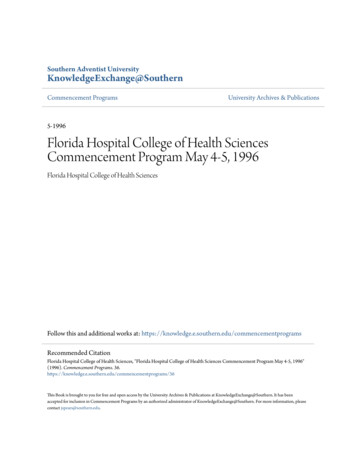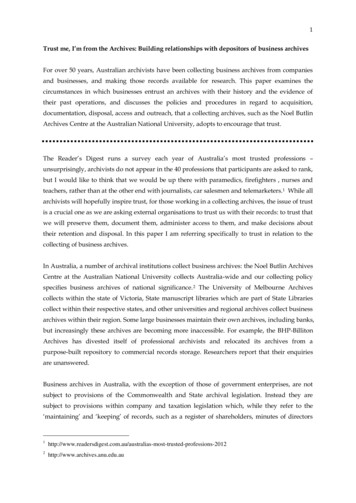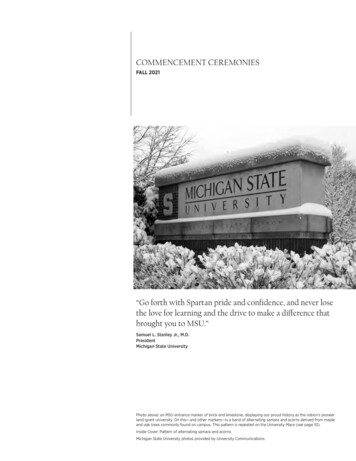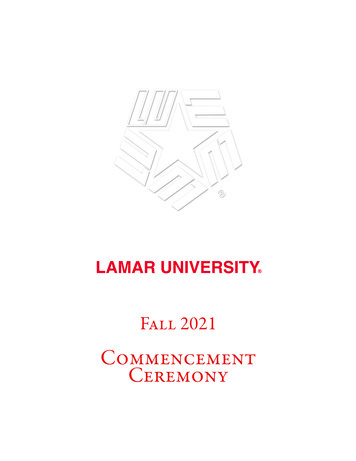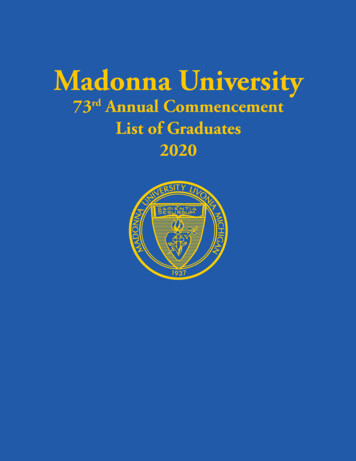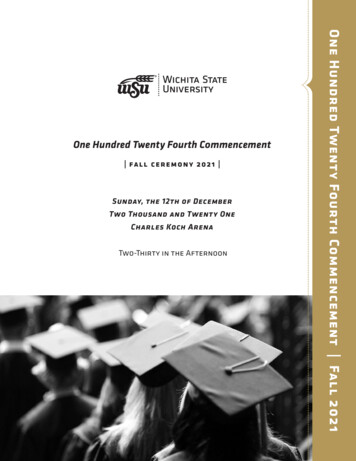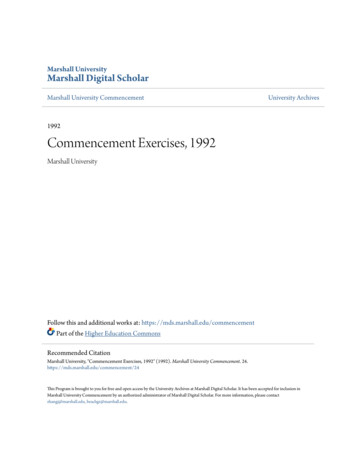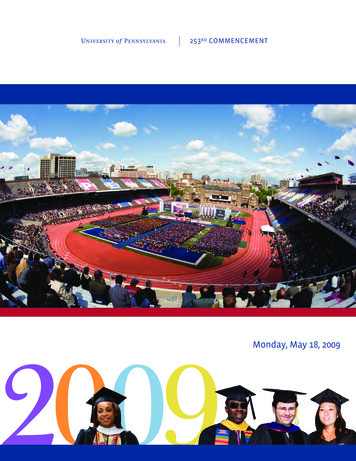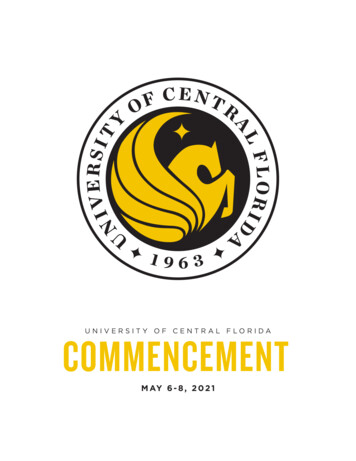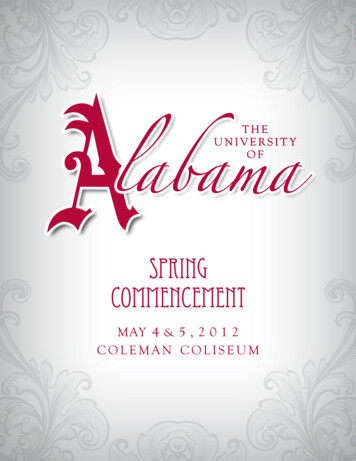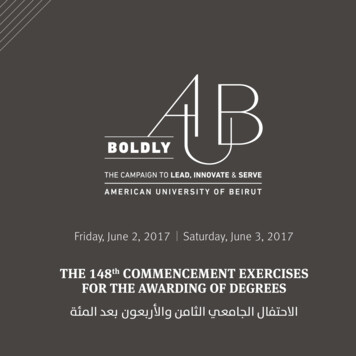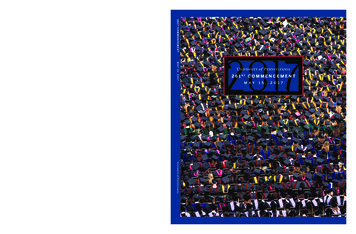
Transcription
2 6 1 ST C O M M E N C E M E N TM AY 1 5 , 2 0 1 720172 6 1 ST C O M M E N C E M E N TM A Y1 5 ,2 0 1 7
U N I V E R S I T Y O F P E N N SY LVA N I AKEEPING FRANKLIN’S PROMISEIn the words of one elegiac tribute, “Great men have two lives: one which occurs while they work on this earth; a secondwhich begins at the day of their death and continues as long as their ideas and conceptions remain powerful.”These words befit the great Benjamin Franklin, whose inventions, innovations, ideas, writings, and public workscontinue to shape our thinking and renew the Republic he helped to create and the institutions he founded, includingthe University of Pennsylvania.Nowhere does Franklin feel more contemporary, more revolutionary, and more alive than at the University ofPennsylvania. His startling vision of a secular, nonsectarian Academy that would foster an “Inclination join’d with anAbility to serve Mankind, one’s Country, Friends and Family” has never ceased to challenge Penn to redefine the scopeand mission of the modern American university.When pursued vigorously and simultaneously, the two missions – developing the inclination to do good and the abilityto do well – merge to help form a more perfect university that educates more capable citizens for our democracy.Penn has embodied and advanced Franklin’s revolutionary vision for 277 years. Throughout its history, Penn hasextended the frontiers of higher learning and research to produce graduates and scholars whose work has enriched thenation and all of humanity.The modern liberal arts curriculum as we know it can trace its roots to Franklin’s innovation to have Penn studentsstudy international commerce and foreign languages.The first medical and business schools in the United States were launched here.And the first general-purpose electronic, digital computer – ENIAC – was invented right here at the University ofPennsylvania.Taking inspiration from Penn’s pioneering legacy, President Amy Gutmann’s Penn Compact 2020 advances theUniversity’s quest to become continually more inclusive, innovative, and impactful. Its bold strategy reinvigoratesFranklin’s founding mission at a time of increased global connectedness and rapid technological advancement. ThePenn community’s extraordinary support of the University’s strategic priorities, as expressed in our record-settingMaking History campaign, enables Penn to work toward the Penn Compact 2020 goals of expanding access for brightstudents from all backgrounds, integrating cutting-edge research and teaching across the disciplines to promoterevolutionary new discoveries, and sharing the benefits of these discoveries through ongoing engagement with our localand global communities.Today, Penn proudly graduates a class of men and women who have shown the intelligence, drive, integrity, andcharacter to become engaged citizens who will serve humanity with distinction. Our Penn graduates are poised to taketheir place as productive democratic citizens and as just and humane stewards of our world.In these challenging and perilous times, a world in need of young men and women who are willing to shoulder the moralresponsibilities of leadership can look to Penn.Franklin wrote: “We may make these times better if we bestir ourselves. The noblest question in the world is ‘What goodmay I do in it?’”The answer to this question will be furnished by Franklin’s newest heirs, the graduates of 2017.1
FRANKLIN FIELDCOMMENCEMENT SEATINGGuests will find this diagram helpful in locating the approximate seating of the degree candidates. The sequence in which thecandidates are presented for degrees is shown on the next page. The list on page 6, detailing the colors of the candidates’hoods according to their fields of study, may further assist guests in identifying the locations of the various schools.In case of emergency, evacuation procedures will be announced.2
C O N T E N TSKeeping Franklin’s Promise. 1Franklin Field Commencement Seating. 2Commencement Ceremony. 4Academic Regalia and Traditions. 6Schools of the University. 8Honorary Degree Citations.11Degrees in Course.15School of Arts and Sciences.15College of Arts and Sciences.15Graduate Division.22College of Liberal and Professional Studies.22School of Engineering and Applied Science. 24Wharton School.30Wharton Undergraduate Division.30Wharton Graduate Division.33School of Nursing.38Perelman School of Medicine.40Law School.42School of Design.44School of Dental Medicine.45School of Veterinary Medicine.46Graduate School of Education. 47School of Social Policy & Practice. 51Annenberg School for Communication.52Graduate Faculties.53ROTC Commissions. 57Principal Academic Honor Societies.58Prizes and Awards.62Faculty Honors. 71Alumni Representatives.78Commencement Marshals.80Trustees of the University. 81Officers of the University.82School Ceremonies.833
COMMENCEMENT CEREMONYThe audience is requested to stand during the Academic Procession, the singing of the National Anthem, the Invocation, theDismissal, and the singing of “The Red and Blue,” and to remain in place until the Academic Procession has left the field.MUSICWestminster BrassJames W. Hala, DirectorSTUDENT PROCESSIONALUMNI PROCESSIONProcession of the Alumni Class RepresentativesProcession of the Class of 1992Procession of the Class of 1967ACADEMIC PROCESSIONOPENING PROCLAMATIONDavid L. Cohen, Chair of the Board of TrusteesTHE NATIONAL ANTHEMLogan Kesel, C’17 Oh, say, can you see, by the dawn’s early light,What so proudly we hailed at the twilight’s last gleaming?Whose broad stripes and bright stars, thro’ the perilous fightO’er the ramparts we watched, were so gallantly streaming.And the rockets’ red glare, the bombs bursting in air,Gave proof through the night that our flag was still there.Oh, say, does that star-spangled banner yet waveO’er the land of the free and the home of the brave?INVOCATIONCharles L. Howard, ChaplainGREETINGSAmy Gutmann, PresidentPresentation of the 25th and 50th Reunion ClassesRemarksACADEMIC HONORSVincent Price, ProvostGREETINGSSantosh Venkatesh, Chair, Faculty SenateCONFERRAL OF HONORARY DEGREESThe PresidentIsabel Allende. Doctor of Humane LettersWriter, journalist, and women’s rights activist;Presidential Medal of Freedom recipientCory A. Booker.Doctor of LawsUnited States Senator for New Jersey;Advocate for criminal justice reform and community empowermentClara Franzini-Armstrong. Doctor of SciencesEmerita Professor of Cell and Developmental Biology,Perelman School of Medicine, University of PennsylvaniaTerry Gross. Doctor of Humane LettersHost and Co-executive Producer, Fresh Air, NPR;National Humanities Medal recipient4
COMMENCEMENT CEREMONY (continued)Ada Sue Hinshaw. Doctor of SciencesInaugural Director, National Institute of Nursing Research, NIH;Groundbreaking researcher in the science of nursingRobert P. Moses. Doctor of Humane LettersFounder and President, The Algebra Project;Educator and civil rights championPaul Muldoon. Doctor of Humane LettersPoet, Howard G.B. Clark ‘21 University Professor in the Humanities,Princeton University, and Poetry Editor, The New YorkerINTRODUCTION OF THE COMMENCEMENT SPEAKERThe ProvostCOMMENCEMENT ADDRESSU.S. Senator Cory A. BookerCONFERRAL OF DEGREES IN COURSEThe PresidentCandidates are presented by the Deans and the Vice Provost for EducationCLOSING REMARKSThe PresidentDISMISSALThe ChaplainTHE RED AND BLUEBy William J. Goeckel, Class of 1896, and Harry E. Westervelt, Class of 1898 Come all ye loyal classmates now, in hall and campus through,Lift up your hearts and voices for the royal Red and Blue.Fair Harvard has her crimson, old Yale her colors too,But for dear Pennsylvania, we wear the Red and Blue.(Chorus)Hurrah! Hurrah! Pennsylvania!Hurrah for the Red and the Blue;Hurrah! Hurrah! Hurrah! Hurrah!Hurrah for the Red and the Blue.RECESSIONAL5
ACA D E M I C R EG A L I A A N D T R A D I T I O N SToday – May 15, 2017 – is the University of Pennsylvania’s 261st Commencement. Penn traces its origins to a deed of trustexecuted in 1740 and is celebrating its 277th birthday this year. President Amy Gutmann will confer bachelor’s, master’s, anddoctoral degrees upon some 6,000 graduates of the University’s 12 schools. Honorary degrees will be awarded to seven individualsof distinction in varied fields, as you will note on pages 11, 12, 13, and 14 in this program.The practice of sporting signs oncaps and gowns as a form of publicproclamation at Commencementdates to the early 1760s, and recallsan even more ancient tradition,originating in the practice of medievaluniversities. Penn’s archives containseveral 18th century broadsides,printed in Latin, which were distributedto Commencement guests along withthe regular programs. The broadsidescontain a series of propositionsclassified under various academicheadings. Presumably, the graduatingstudents were willing to defend thesetheses against any assertions to thecontrary. On the eve of the Revolution,however, statements such as “therights of the people are as divine as therights of their rulers” must have metwith widespread sympathy.ACADEMIC CEREMONYAND REGALIACommencement exercises at Americanuniversities and colleges traditionallyare composed of three essentialelements: the Academic Procession,the conferring of degrees, and theCommencement address. This practicehas been codified since 1895, whena national conference on academiccostume and ceremony was proposedand a plan known initially as the“Intercollegiate System” was formallyadopted. The Trustees of the Universityof Pennsylvania incorporated this codein the Statutes of the University inNovember 1896. Now under the aegisof the American Council on Education,the “Academic Costume Code andAcademic Ceremony Guide” wasrevised in 1932 and 1960.* Throughoutthe 20th century, Commencement atPenn has, with minor modifications,followed the dictates of the code and itsrevisions.By 1896, however, Penn had beengranting degrees for nearly 140 years.Like other American colonial colleges,Penn borrowed its 18th centuryCommencement rituals directly fromthe English universities. In Englandthe history of academic dress reaches6back to the early days of the oldestschools. As early as the second halfof the 14th century, the statutes ofcertain colleges prohibited “excess inapparel” and required the wearing of along gown. It is still an open questionas to whether academic dress finds itssources chiefly in ecclesiastical or incivilian dress. It is often suggested thatgowns and hoods were the simplest,most effective method of staying warmin the unheated, stone buildings whichhoused medieval scholars. In anycase, academic regalia had evolvedto contemporary familiarity by thetime Benjamin Franklin was awardedan honorary Doctor of Laws by theUniversity of St. Andrews in 1759.TRADITIONS AND CURRENTPRACTICE AT PENNIn April 1887, on the recommendationof a committee of the faculty, theTrustees adopted the “‘Pennsylvania’System of Academic Costume.” Thecolors and trimmings of hoods andcaps were regularized according tofaculty and degree. Beginning withthe Commencement of 1887, the“‘Pennsylvania’ System” was publishedin each year’s program and adherenceto its rules was expected of trustees,faculty, and students alike. Beginningin 1896, the “‘Pennsylvania’ System”was superseded by the “IntercollegiateSystem,” which has continued in effectto the present time.The gowns used in American academicceremonies vary according to thehighest degree awarded to the wearer.The gown for the bachelor’s degree haspointed sleeves; it is designed to beworn closed. The gown for the master’sdegree has an oblong sleeve, open atthe wrist. The sleeve base hangs downin the traditional manner. The rearpart of its oblong shape is square cutand the front has an arc cut away. Themaster’s gown may be worn open orclosed. The doctoral gown is a moreelaborate costume faced down the frontwith black velvet and across the sleeveswith three bars of the same; thesefacings and crossbars may be of velvetof the color distinctive to the field ofstudy to which the degree pertains. Thedoctoral gown has bell-shaped sleevesand may be worn open or closed.Some institutions have authorizeddoctoral gowns in colors other thanthe customary black; holders of theUniversity of Pennsylvania doctoratemay wear red and blue gowns.The hoods are lined in silk with theofficial color or colors of the college oruniversity which granted the highestdegree held by the wearer; more thanone color is shown by division of thefield color in a variety of ways, such asby chevron or chevrons. The bindingor edging of the hood is in velvet, withwidths of two inches, three inches, andfive inches for the bachelor’s, master’s,and doctoral degrees, respectively. Thecolor of the border indicates the fieldof study to which the degree pertains.University of Pennsylvania graduateswear a hood lined in red with a bluechevron. The mortarboard cap isstandard, though soft square-toppedcaps are permissible. Recipients ofdoctorates may wear a gold tasselfastened to the middle point of the topof the cap; all others wear black.Degrees shall be conferred todayaccording to the following order:Arts & Letters, whiteScience, golden yellowBusiness Administration, mustardNursing, apricotMedicine, greenLaw, purpleFine Arts (including Design), brownDental Medicine, lilacVeterinary Medicine, grayEducation, light blueSocial Work, citronPhilosophy, dark blue
ACADEMIC REGALIA AND TRADITIONS (continued)ACADEMIC PROCESSIONThe order for today’s AcademicProcession is as follows:Mace BearerPresident and ProvostChair of the Board ofTrusteesCommencement SpeakerCandidates for Honorary DegreesDeansUNIVERSITY MACEThe Secretary of the University carriesthe University mace, the symbol ofauthority of the University, at the headof the Academic Procession. It wasa gift of the family of William MurrayGordon, M.D. 1910. It is adorned withthe seal and arms of the University,the Penn and Franklin coats-of-arms, adepiction of the Rittenhouse Orrery, anda thistle symbolizing the early ties of theUniversity with Scotland.TrusteesOfficers of the UniversityFacultyPRESIDENT’S BADGEOF OFFICEThe President wears as a badge ofoffice a silver medallion of whichone face is engraved, like the mace,with the University seal. The obverseof the President’s medal bears the“orrery seal,” designed in 1782 byFrancis Hopkinson, A.B. 1757, a signerof the Declaration of Independence.The medal, suspended on a chaincomposed of silver links, was givenby the late Trustee Thomas SovereignGates, Jr., A.B. 1928, LL.D. 1956,on the occasion of Sheldon Hackney’sinauguration as President in October1981.OverseersVisiting DignitariesU N I V E R S I T Y S E A L A N D SY M B O LSSEAL OF THE CORPORATIONPENN COAT-OF-ARMSSCHOOL COLORSThe Trustees of theUniversity have anofficial seal thatis, in effect, thesignature of theCorporation. It hadits origin at a meetingof the Board of Trustees in 1755 withBenjamin Franklin as Chairman.Though the seal underwent changesover the years, the most recent design,approved in 1932 and adopted in 1933,returned it to virtually its original form.The Penn coat-ofarms was derivedby combining thecoat of arms ofBenjamin Franklinand that of WilliamPenn’s family. The dolphin on the redchief was part of Franklin’s coat-ofarms and the three silver plates on ablue chevron were a part of Penn’s.The two were combined on a whiteshield along with two open volumesrepresenting the University’seducational purpose.Eighteenth century Americanacademic institutions did nothave colors. The earliest knownrepresentation of the combinedPenn colors, red and blue, is on theincised lid of the 1871 College Hallcornerstone.The seal is composed of seven booksstacked on a slanted desktop, withthe books bearing the following titles,representing the curricula of theday: Theolog, Astronom, Philosoph,Mathemat, Logica, Rhetorica,Grammatica. On the periphery ofthe stack of books appears theUniversity motto, Leges Sine MoribusVanae, and the whole is encircledwith the inscription UniversitatisPennsylvaniensis.MOTTO:LEGES SINE MORIBUS VANAEThe motto of the University, LegesSine Moribus Vanae, means “Lawswithout morals are useless.” It comesfrom the longer quotation fromHorace, “Quid leges sine moribusvanae proficiunt?” the sense of whichis “Of what avail are empty lawswithout (good) morals?”One legend traces their origins to anearly track meet at Saratoga, NewYork, between Penn, Harvard, andYale. When asked by the officials whatcolors would be representing thePenn team, the Pennsylvania captainreportedly replied, “We’re going to bewearing the colors of the teams webeat,” i.e., Harvard Crimson and YaleBlue. We shall assume that Penn wasvictorious and thus remained loyal tothe Red and Blue.* This and additional material which follows is taken from “An Academic Costume Code and Academic Ceremony Guide” in American Council on Education, AmericanUniversities and Colleges, 14th ed. (New York: Walter de Gruyter, 1992).7
S C H O O LS O F T H E U N I V E R S I T YSCHOOL OF ARTSAND SCIENCES (1755)The School of Arts and Sciences(SAS) is the direct descendant ofthe College of Philadelphia, whereBenjamin Franklin established thefirst modern arts and sciencescurriculum in the English colonies.Undergraduate programs for mendate to the chartering of the Collegein 1755; the College of Liberal Artsfor Women was founded in 1933. TheGraduate School was established in1882 with the appointment of a Facultyof Philosophy. The College of Liberaland Professional Studies (lifelonglearning) traces its roots to 1892. TheSchool of Arts and Sciences was bornin 1974 with the merger of the Collegeof Arts and Sciences, the College forWomen, the Graduate School, andfour social science departments fromWharton. Today SAS is the largest ofthe University’s 12 schools, providinga liberal arts education for all Pennundergraduates and supportinggraduate studies, basic research,and continuing education across thefull range of the humanities, naturalsciences, and social sciences. TheSchool has 27 departments with 504standing faculty, 18 research centers,four interschool institutes, and 10,000students.PERELMAN SCHOOL OF MEDICINE(1765)Established in 1765 as the nation’s firstmedical school, what is now knownas the Raymond and Ruth PerelmanSchool of Medicine at the University ofPennsylvania continues a rich traditionof providing the nation’s best medicaltraining and education, with service toits community as a cornerstone. Today,the School, which has been namedto the top five medical schools in thenation by U.S. News & World Reportfor the past 20 consecutive years,honors its longstanding commitmentto advancing knowledge and improvinghealth close to home and acrossthe world through research, patientcare, and the education of traineesin an inclusive culture that embracesdiversity. More than 780 studentsare pursuing medical degrees inthe Perelman School, and over 600are studying toward doctorates in8biomedical sciences, with nearly200 more enrolled in joint MD/PhDprograms. Across the School’s affiliatedhospitals, 1,300 residents and fellowsare completing their medical training.Over the past decade, the PerelmanSchool of Medicine has consistentlyranked among the top recipients ofresearch funding from the NationalInstitutes of Health.LAW SCHOOL (1790)Penn’s engagement in legal educationbegan in 1790 with a series of lecturesto President Washington and his cabinetby James Wilson, the University’sfirst law professor, a signer of theDeclaration of Independence, and oneof the original justices of the SupremeCourt of the United States. A formalprogram of instruction in law wasestablished in 1850 under GeorgeSharswood, and innovative legaleducation has been part of the Pennfabric since that time. Today, Penn Lawprovides a cross-disciplinary, globallyfocused legal education taught bypreeminent scholars, approximately70 percent of whom hold advanceddegrees in fields in addition to law.Students augment the teachingprovided by Penn Law faculty withclasses taken — and certificates ofstudy and joint degrees earned —in sister schools and departmentsthroughout the University. PennLaw has 912 students and 66 fulltime faculty. Penn Law awards fivedegrees: Juris Doctor; Master of Lawsfor internationally trained lawyers;Master of Comparative Laws; Doctor ofJuridical Science; and a Master in Lawfor non-lawyers.SCHOOL OF ENGINEERING ANDAPPLIED SCIENCE (1852)The School of Engineering and AppliedScience is one of the oldest in theUnited States, tracing its beginningsto the establishment of the Schoolof Mines, Arts and Manufactures in1852. The first graduate of the Schoolreceived a Bachelor of Science degreein 1854. Since that time, the Schoolhas grown into a center of excellencein the creation of technology andin technology education. Its spiritof innovation led to the creation in1946 of ENIAC, the first all-electronic,large-scale, general-purpose digitalcomputer, making Penn Engineering thebirthplace of the computer age. Today,Penn Engineering offers a wide range ofundergraduate and graduate programs,including the first alternative liberalarts program based in an engineeringschool. Penn Engineering is particularlydistinguished by its interdisciplinary,cross-school programs such asManagement and Technology, DigitalMedia Design, Biotechnology, and theSingh Program in Networked & SocialSystems Engineering. Penn Engineeringcurrently has 120 standing faculty,approximately 1,600 undergraduatestudents, 1,700 graduate students, and15 research centers and institutes.SCHOOL OF DESIGN (1869)Although the School of Design datesits founding from 1890, architecturecourses were first offered at theUniversity of Pennsylvania in 1869,making Penn’s architecture programthe second oldest in the United States.In 1921, the Department of Architecturejoined with the Department of Musicand Fine Arts to create an independentundergraduate School of Fine Artsmodeled on the French École desBeaux Arts. In 1958, the School wasrenamed the Graduate School of FineArts, reflecting the shift to graduatedegree offerings in architecture, cityand regional planning, landscapearchitecture and fine arts. In the 1980s,a program in historic preservation wasadded. To more accurately capturethe School’s sphere of influence, itwas renamed the School of Design in2003. Today, with a standing faculty of43, approximately 160 lecturers andassociated faculty, and more than 700students, the School prepares studentsto address complex socioculturaland environmental issues throughthoughtful inquiry, creative expression,and innovation.
SCHOOLS OF THE UNIVERSITY (continued)SCHOOL OF DENTAL MEDICINE(1878)Established in 1878 as the DentalDepartment of the University ofPennsylvania, the School of DentalMedicine is among the oldest universityaffiliated dental institutions in thecountry, with a history deeply rooted inforging precedents in dental education,research, and patient care. In 1897,Thomas W. Evans, a Philadelphia nativeand clinician who spent most of his lifein France as the dentist to Europeannobility, left his estate to create a dentalschool that was “second to none.”Evans’ bequest would become one withthe University, creating the Thomas W.Evans Museum and Dental Institute,which opened in 1915. Today, the EvansBuilding remains the site of much ofthe School’s clinical instruction. Thedental campus also includes the RobertSchattner Center and the Leon LevyCenter for Oral Health Research, hometo the basic sciences and extensiveresearch activities. Penn DentalMedicine is a major provider of care inWest Philadelphia and through outreachprograms student
Charles L. Howard, Chaplain GREETINGS Amy Gutmann, President Presentation of the 25th and 50th Reunion Classes Remarks ACADEMIC HONORS Vincent Price, Provost GREETINGS Santosh Venkatesh, Chair, Faculty Senate CONFERRAL OF HONORARY DEGREES The President
